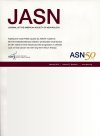Effects of Zibotentan Alone and in Combination with Dapagliflozin on Fluid Retention in Patients with CKD
Increasing doses of the endothelin receptor antagonist zibotentan and lower eGFR were associated with a higher risk of fluid retention.The higher risk of fluid retention could be attenuated by the combination of zibotentan with the sodium-glucose cotransporter 2 inhibitor dapagliflozin.
Background
Endothelin receptor antagonists (ERAs) reduce albuminuria but are limited by fluid retention risk, particularly in patients with CKD. Combining ERAs with sodium-glucose cotransporter 2 (SGLT2) inhibitors, which have diuretic effects, offers a promising strategy to mitigate fluid retention. In this post hoc analysis of the Zibotentan and Dapagliflozin for the Treatment of CKD (ZENITH-CKD) trial, we assessed fluid dynamics in patients with CKD treated with the ERA zibotentan alone and in combination with the SGLT2 inhibitor dapagliflozin.
Methods
In the ZENITH-CKD trial, 508 patients with CKD (eGFR ≥20 ml/min per 1.73 m2 and a urinary albumin-creatinine ratio of 150–5000 mg/g) were randomized to treatment with placebo, dapagliflozin 10 mg plus placebo, zibotentan (0.25, 1.5, or 5 mg) plus dapagliflozin 10 mg, and zibotentan 5 mg plus placebo. We evaluated correlations between changes in fluid retention markers and bioimpedance-measured extracellular fluid in response to zibotentan treatment. We used Cox proportional hazards regression to assess the association between zibotentan/dapagliflozin treatment, baseline characteristics, and fluid retention and the relationship between zibotentan plasma exposure and fluid retention.
Results
After 3 weeks of treatment with zibotentan 0.25, 1.5, or 5 mg plus dapagliflozin 10 mg, changes in body weight (β=0.36 [95% confidence interval (CI), 0.26 to 0.45]) per kg, B-type natriuretic peptide (β=0.38 [95% CI, 0.22 to 0.54]) per doubling, and hemoglobin (β=−0.29 [95% CI, −0.48 to −0.10]) per g/dl were independently associated with changes in extracellular fluid. Higher doses of zibotentan were associated with significantly higher risk of fluid retention compared with dapagliflozin alone (zibotentan 5 mg hazard ratio (HR) 8.50 [95% CI, 3.40 to 21.30]). The HR attenuated when zibotentan was combined with dapagliflozin (zibotentan/dapagliflozin 5/10 mg HR 3.09 [95% CI, 1.08 to 8.80], zibotentan/dapagliflozin 1.5/10 mg 2.70 [95% CI, 1.44 to 5.07], and zibotentan/dapagliflozin 0.25/10 mg HR 1.21 [95% CI, 0.50 to 2.91]). The risk of fluid retention was higher with higher zibotentan exposure and lower eGFR.
Conclusions
High doses of zibotentan were associated with a higher risk of fluid retention, which was attenuated with lower doses and the addition of dapagliflozin.
Clinical Trial registry name and registration number:
ZENITH-CKD Trial, NCT04724837.




